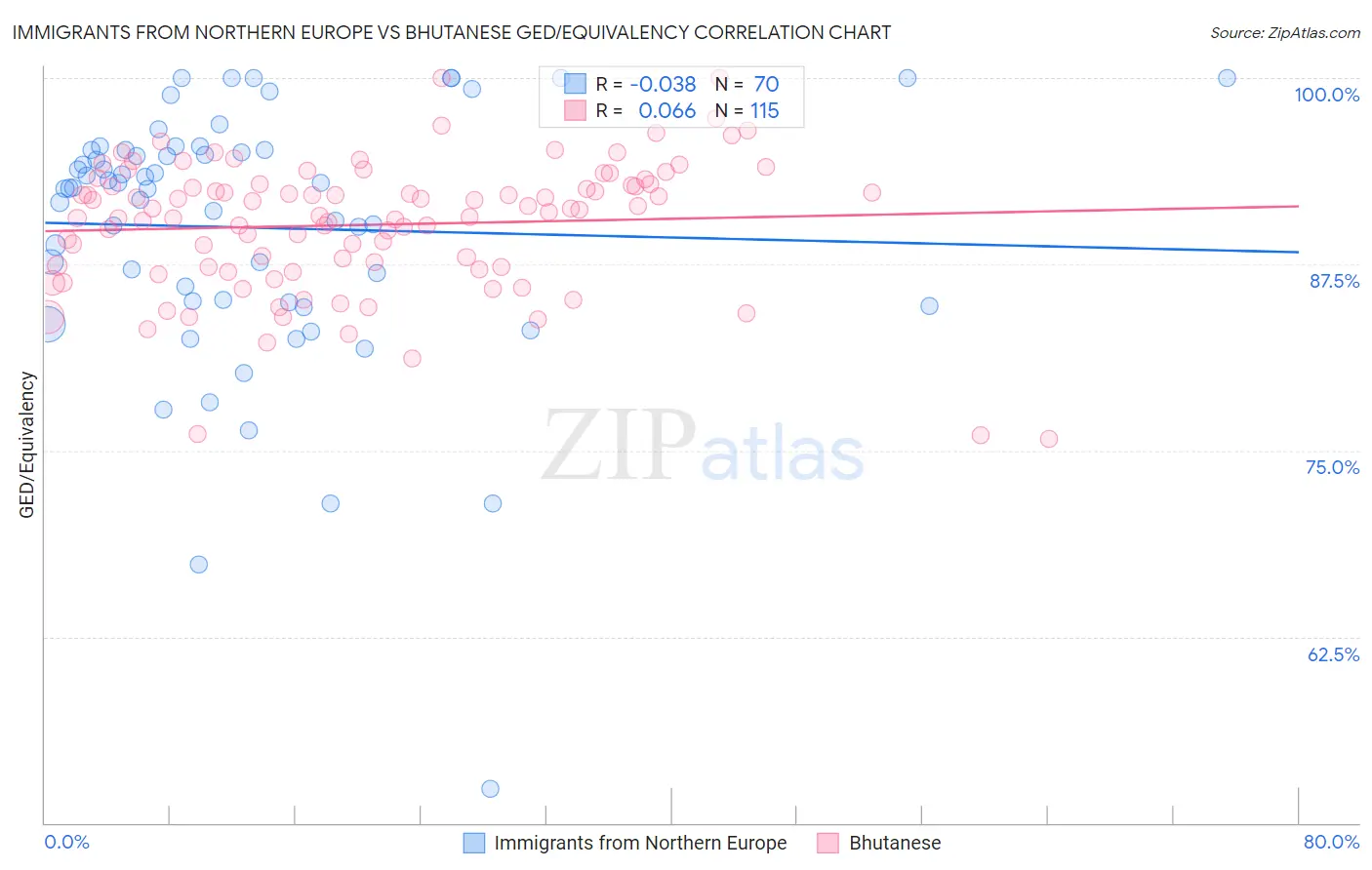Immigrants from Northern Europe vs Bhutanese GED/Equivalency
COMPARE
Immigrants from Northern Europe
Bhutanese
GED/Equivalency
GED/Equivalency Comparison
Immigrants from Northern Europe
Bhutanese
88.5%
GED/EQUIVALENCY
99.8/ 100
METRIC RATING
28th/ 347
METRIC RANK
88.4%
GED/EQUIVALENCY
99.8/ 100
METRIC RATING
31st/ 347
METRIC RANK
Immigrants from Northern Europe vs Bhutanese GED/Equivalency Correlation Chart
The statistical analysis conducted on geographies consisting of 477,226,871 people shows no correlation between the proportion of Immigrants from Northern Europe and percentage of population with at least ged/equivalency education in the United States with a correlation coefficient (R) of -0.038 and weighted average of 88.5%. Similarly, the statistical analysis conducted on geographies consisting of 455,590,907 people shows a slight positive correlation between the proportion of Bhutanese and percentage of population with at least ged/equivalency education in the United States with a correlation coefficient (R) of 0.066 and weighted average of 88.4%, a difference of 0.080%.

GED/Equivalency Correlation Summary
| Measurement | Immigrants from Northern Europe | Bhutanese |
| Minimum | 52.3% | 75.7% |
| Maximum | 100.0% | 100.0% |
| Range | 47.7% | 24.3% |
| Mean | 90.0% | 90.2% |
| Median | 92.6% | 91.1% |
| Interquartile 25% (IQ1) | 85.1% | 87.3% |
| Interquartile 75% (IQ3) | 95.2% | 92.9% |
| Interquartile Range (IQR) | 10.2% | 5.6% |
| Standard Deviation (Sample) | 8.7% | 4.5% |
| Standard Deviation (Population) | 8.7% | 4.5% |
Demographics Similar to Immigrants from Northern Europe and Bhutanese by GED/Equivalency
In terms of ged/equivalency, the demographic groups most similar to Immigrants from Northern Europe are Polish (88.5%, a difference of 0.030%), Immigrants from Lithuania (88.6%, a difference of 0.040%), Turkish (88.5%, a difference of 0.050%), Russian (88.6%, a difference of 0.080%), and Slovak (88.6%, a difference of 0.080%). Similarly, the demographic groups most similar to Bhutanese are Danish (88.4%, a difference of 0.020%), Turkish (88.5%, a difference of 0.030%), Polish (88.5%, a difference of 0.050%), Immigrants from Sweden (88.4%, a difference of 0.060%), and Immigrants from Japan (88.4%, a difference of 0.070%).
| Demographics | Rating | Rank | GED/Equivalency |
| Swedes | 99.9 /100 | #19 | Exceptional 88.8% |
| Maltese | 99.9 /100 | #20 | Exceptional 88.6% |
| Luxembourgers | 99.8 /100 | #21 | Exceptional 88.6% |
| Immigrants | Ireland | 99.8 /100 | #22 | Exceptional 88.6% |
| Russians | 99.8 /100 | #23 | Exceptional 88.6% |
| Slovaks | 99.8 /100 | #24 | Exceptional 88.6% |
| Estonians | 99.8 /100 | #25 | Exceptional 88.6% |
| Immigrants | Australia | 99.8 /100 | #26 | Exceptional 88.6% |
| Immigrants | Lithuania | 99.8 /100 | #27 | Exceptional 88.6% |
| Immigrants | Northern Europe | 99.8 /100 | #28 | Exceptional 88.5% |
| Poles | 99.8 /100 | #29 | Exceptional 88.5% |
| Turks | 99.8 /100 | #30 | Exceptional 88.5% |
| Bhutanese | 99.8 /100 | #31 | Exceptional 88.4% |
| Danes | 99.8 /100 | #32 | Exceptional 88.4% |
| Immigrants | Sweden | 99.7 /100 | #33 | Exceptional 88.4% |
| Immigrants | Japan | 99.7 /100 | #34 | Exceptional 88.4% |
| Immigrants | South Central Asia | 99.7 /100 | #35 | Exceptional 88.4% |
| Immigrants | Belgium | 99.7 /100 | #36 | Exceptional 88.3% |
| Immigrants | Austria | 99.7 /100 | #37 | Exceptional 88.3% |
| Burmese | 99.7 /100 | #38 | Exceptional 88.3% |
| Immigrants | Israel | 99.6 /100 | #39 | Exceptional 88.2% |